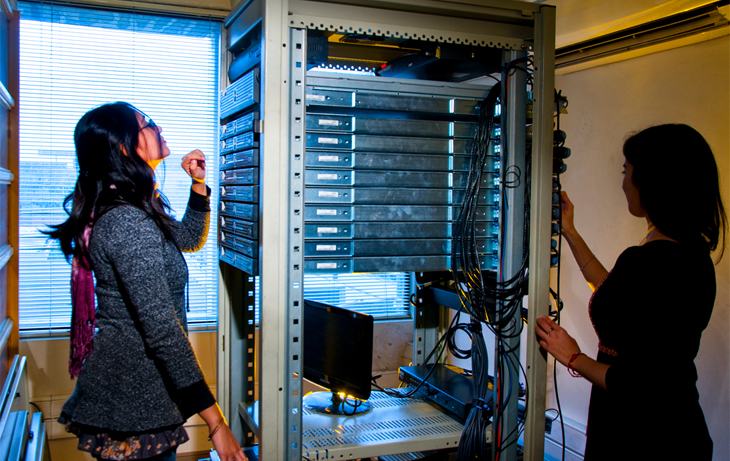Laboratorio de Computación Distribuida y Modelamiento de Procesos (PMDC Lab)
Descripción
El objetivo del laboratorio es aplicar modelación matemática y técnicas computacionales de punta que permitan un entendimiento profundo de los procesos que gobiernan el funcionamiento y/o operación de sistemas biológicos, químicose industriales de gran complejidad. Dentro de las técnicas que se desarrollan y utilizan en el laboratorio están la modelación molecular, la modelación matemática, la modelación de procesos, el cálculo distribuido, etc.
Equipamiento e instrumentos
El laboratorio cuenta con 2 clusters:
- Cluster de producción "Eowyn": 80 cores, CPU QuadCore AMD OpteronTM, 16 x 10 GBi RAM, 1 TBi de disco duro en RAID 1, conectado a través de un switch de red de 1 Gbs. Recientemente se ha mejorado el equipamiento del cluster con la llegada de dos nuevos nodos de cálculo especializado. Estos nodos contienen tarjetas GPU NVIDIA que permiten que el equipo pueda ser utilizado en la simulación de sistemas de mayor complejidad y volumen. Las especificaciones de estos equipos son: 40 cores Intel Xeon, 2 × 64 GBi RAM, 2 tarjetas Tesla K20X (2 × 2496 GPU cores). 3 TBi espacio de disco en RAID 1
- Cluster de docencia "Gandalf": 8 cores, PentiumTM III, 1 x 4 GBi RAM, 1 TBi disco duro en RAID 1, conectado a través de un switch de red de 1 Gbs.
- 5 WorkStations.
- 1 Notebook.
Miembros (2014 – 2015)
- Álvaro Ceroni (pregrado) “Design and implementation of Distributed Control Systems”.
- Daniela Rivas (pregrado) “Molecular modeling and study of the 1A-IRE isoform of human DMT1 protein”.
- Carla Saéz (pregrado) “Mathematical modeling of the movement of iron transport proteins in Caco-2 cells”.
- Andrea Colins (magister) “Mathematical modeling of the iron's transmembrane fluxes on Caco-2 cells”.
- Daniel Morales (magister) “Mathematical modeling of iron's homeostasis in human Caco2 cells”.
Académico responsable
- Prof. J. Cristian Salgado
Teléfono: +562 29780694
Correo electrónico: jsalgado@ing.uchile.cl
Dirección: Av. Tupper 2007, Santiago, Chile. 6to piso Edificio Eléctrica
Página web: http://www.cec.uchile.cl/~jsalgado/pmdc_lab.php
Proyectos asociados
- FONDECYT 1130317 (2013 - 2016): "A systems biology approach for studying and understanding cellular processes involved in the regulation of intestinal iron absorption". Investigador Principal.
- FONDECYT 1120280 (2012 – 2015): "Searching for possible deprotonation sites for substrates and inhibitors of human MAO-A". Co investigador con Dr. Gerald Zapata y Dra. Angélica Fierro.
- International Scientific Cooperation Project – CONICYT (2013 – 2014): "Molecular docking study of PEGylated proteins for the analysis of their behavior on ion exchange (IEX) and hydrophobic interaction (HIC) chromatography". Co investigador con Dra. María Elena Lienqueo y Dr. Gerald Zapata.
- FONDECYT Iniciación 11080016 (2008 – 2011): "Mathematical modeling of the interaction between cell penetrating TIR BB loop decoy peptides (BBPs) and toll-like receptor 4 and 2 (TLR4 and TLR2)". Investigador Principal.
Publicaciones (2009-2014)
- C. Celis-Barros, L. Saavedra-Rivas, J.C. Salgado, B.K. Cassels, G. Zapata-Torres, Molecular dynamics simulation of halogen bonding mimics experimental data for cathepsin L inhibition, Journal of Computer-Aided Molecular Design, 29(1) (2014) 37. (ISI).
- G. Zapata-Torres, A. Fierro-Huerta, S. Miranda-Rojas, C. Guajardo, P. Saez-Briones,
J.C. Salgado, C. Celis-Barros, Influence of Protonation on Substrate and Inhibitor Interactions at the Active Site of Human Monoamine Oxidase-A, Journal of Chemical Information and Modeling, 52(5) (2012) 1213. (ISI).
- K. Flores-Olave, J.C. Salgado, G. Zapata-Torres, M.J. Gonzalez, M.A. Hermoso, Effect of the electrostatic potential on the internalization mechanism of cell penetrating peptides, Journal of Biotechnology, 17(3) (2012) 485. (ISI).
- M.E. Lienqueo, A. Mahn, J.C. Salgado, C. Shene, Mathematical Modeling of Protein Chromatograms, Chemical Engineering & Technology, 35 (2012) 46. (ISI).
- D. Baeza, J.C. Salgado, Z.P. Gerdtzen, Design and simulation of a controller system for metabolic shift regulation in mammalian cells, BMC Proceedings, 5(Supp8) (2011) p11. (NonISI).
- J.C. Salgado, A. Olivera,, Z.P. Gerdtzen , V. Tapia , C. Conca , M.T. Nunez, Mathematical Modeling of the Dynamic Storage of Iron in Ferritin, BMC Systems Biology Journal, 4 (2010) 147. (ISI).
- M.E. Lienqueo, C.Shene, A. Quiroz, O.Salazar, J.C. Salgado, J.A. Asenjo, Experimental validation of mathematical model predictions for the selection of optimal polypeptide tags to assist the purification of recombinant proteins, Journal of Separations and Purification Technology, 45 (2010) 2153. (ISI).
- T. Vargas, M. Colet and J.C. Salgado, A Novel Mathematical Model for the Study of Electrochemical Nucleation of Metals on Foreign Substrates from the Analysis of Potentiostatic Current-Transients, ECS Transactions. 28 (6) (2010) 155-163. (NonISI).
- Z.P. Gerdtzen, J.C. Salgado, A. Osses, J.A. Asenjo, I. Rapaport, B.A. Andrews, Modeling heterocyst pattern fomation in cyanobacteria, BMC Bioinformatics, 10 (2009) (Suppl 6) S16. (ISI).
- A. Mahn, M.E. Lienqueo, J.C. Salgado, Methods of calculating protein hydrophobicity and their application in developing correlations to predict hydrophobic interaction chromatography retention, Journal of Chromatography A, 1216 (2009) 1838. (ISI).
- M.E. Lienqueo, J.C. Salgado, O. Giaverini, J.A. Asenjo, Computer-aided design to select optimal polypeptide tags to assist the purification of recombinant proteins, Journal of Separations and Purification Technology, 65 (2009) 86. (ISI).
Estudiantes formados (2009 – 2014)
- 12 estudiantes de pregrado de las especialidades de Ingeniería Civil Química e Ingeniería Civil en Biotecnología
- 4 estudiantes de magister en Ingeniería Civil Química y Biotecnología


